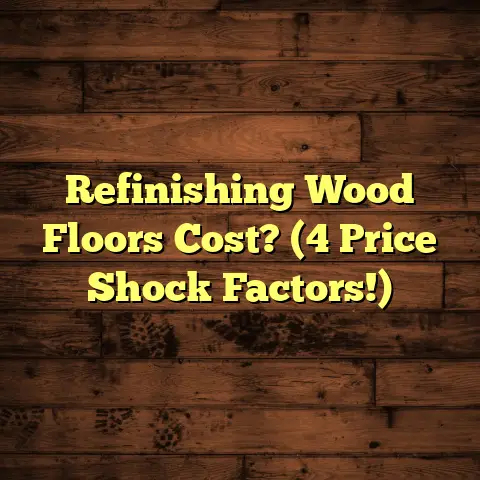Laminate Flooring Costs: What To Expect? (1 Hour Read)
Have you ever walked into a room and been completely floored (pun intended!) by the sheer beauty of the flooring? I know I have. There’s something about a well-chosen floor that can truly transform a space.
And when it comes to affordable, durable, and stylish options, laminate flooring often tops the list. It mimics the look of hardwood, tile, or even stone, without breaking the bank.
But while laminate is generally seen as a budget-friendly choice, the actual cost can vary quite a bit. It’s not as simple as just looking at the price per square foot.
That’s why I’m here to break down all the factors that influence the final cost of laminate flooring. We’ll cover everything from the materials themselves to installation and even long-term maintenance.
By the end of this article, you’ll have a clear understanding of what to expect when budgeting for your new laminate floors. Let’s dive in!
1. Understanding Laminate Flooring
So, what exactly is laminate flooring? Let’s get down to the nitty-gritty.
Laminate is a multi-layer synthetic flooring product fused together through a lamination process. Think of it as a high-tech sandwich, with each layer serving a specific purpose.
Here’s a breakdown of the layers:
-
Wear Layer: This is the top layer, a transparent coating that protects the floor from scratches, stains, and fading. The thicker the wear layer, the more durable the floor will be.
-
Design Layer: This is where the magic happens! It’s a high-resolution photographic image that mimics the look of wood, tile, or stone.
-
Core Layer: This is the heart of the laminate, usually made of high-density fiberboard (HDF) or medium-density fiberboard (MDF). It provides stability and resistance to impacts.
-
Backing Layer: This bottom layer provides a moisture barrier and helps to stabilize the floor.
The Manufacturing Process
The manufacturing process plays a big role in the cost of laminate. Higher-quality laminates often undergo a more rigorous and precise manufacturing process.
The layers are fused together under high heat and pressure. The quality of the materials used, the precision of the printing, and the durability of the wear layer all contribute to the final price.
For instance, some manufacturers use more advanced printing techniques to create a more realistic and textured surface. Others use thicker and more durable wear layers to provide better protection against wear and tear.
Types of Laminate Flooring
Not all laminate is created equal. There are different types available, each with its own price point and features.
-
Standard Laminate: This is your basic, entry-level option. It’s affordable and suitable for low-traffic areas.
-
High-Pressure Laminate (HPL): This is a more durable option, made with a higher pressure lamination process. It’s more resistant to scratches and impacts, making it suitable for high-traffic areas.
-
Water-Resistant Laminate: This type is designed to resist moisture, making it a good choice for kitchens and bathrooms.
-
Waterproof Laminate: Yes, it exists! This is the most advanced type of laminate, offering complete protection against water damage. It is often more expensive, but worth it for peace of mind in moisture-prone areas.
Lifespan and Maintenance
Compared to other flooring types, laminate offers a good balance of lifespan and maintenance.
With proper care, laminate flooring can last anywhere from 10 to 20 years, or even longer. Regular sweeping and occasional mopping with a laminate-specific cleaner are usually all that’s needed to keep it looking its best.
Compared to hardwood, laminate is more resistant to scratches and stains. And compared to carpet, it’s much easier to clean and maintain.
2. Breakdown of Costs
Okay, let’s get down to brass tacks and talk about the actual costs involved. This is where things can get a bit tricky, but I’ll break it down as clearly as possible.
Material Costs
The cost of the laminate flooring itself is the first thing you’ll need to consider. This can vary widely depending on the quality, brand, and design you choose.
-
Budget Options: You can find laminate flooring for as low as \$1 to \$3 per square foot. These are typically thinner laminates with a less durable wear layer.
-
Mid-Range Options: Expect to pay around \$3 to \$5 per square foot for mid-range laminates. These offer a good balance of quality and price.
-
Premium Options: High-end laminates can cost \$5 to \$10 per square foot or more. These often feature thicker wear layers, more realistic designs, and waterproof properties.
Brand Reputation and Design Choices
Just like with any product, brand reputation plays a role in the cost. Well-known brands often charge a premium for their name and perceived quality.
Design choices also impact the price. More realistic wood-look laminates, with embossed textures and intricate patterns, tend to be more expensive.
Also, keep in mind that certain colors and patterns may be more popular and therefore more expensive. You also have to consider the thickness of the plank. Typically, thicker planks are more durable, comfortable underfoot, and can better replicate the feel of real wood.
Installation Costs
Now, let’s talk about installation. You have two main options here: professional installation or DIY.
-
Professional Installation: Hiring a professional installer will add to the overall cost, but it can save you time, hassle, and potential headaches. Professional installation typically costs between \$2 and \$5 per square foot.
-
DIY Installation: If you’re handy and have some experience with home improvement projects, you can save money by installing the laminate yourself. However, be prepared to invest time and effort, and make sure you have the right tools and knowledge.
Labor Costs
Labor costs can vary depending on your location, the complexity of the job, and the installer’s rates. More complex jobs, such as installing laminate in a room with lots of corners or stairs, will typically cost more.
Additional Materials
Don’t forget to factor in the cost of additional materials needed for installation. These can include:
-
Underlayment: This is a foam or cork layer that goes between the subfloor and the laminate. It provides cushioning, sound insulation, and moisture protection. Underlayment typically costs between \$0.30 and \$1 per square foot.
-
Adhesives: Some laminate floors require adhesive to secure them to the subfloor. The cost of adhesive will depend on the type and amount needed.
-
Tools: If you’re doing a DIY installation, you’ll need to purchase or rent tools such as a tapping block, pull bar, saw, and measuring tape.
Additional Costs
Beyond the material and installation costs, there are a few other potential expenses to keep in mind.
-
Old Flooring Removal: If you need to remove old flooring before installing the laminate, that will add to the cost. Removal costs can range from \$1 to \$3 per square foot, depending on the type of flooring and the complexity of the job.
-
Subfloor Preparation: A smooth, level subfloor is essential for a successful laminate installation. If your subfloor needs repairs or leveling, that will add to the cost.
-
Cleaning and Maintenance Products: While laminate is relatively easy to maintain, you’ll still need to purchase cleaning products specifically designed for laminate floors.
3. Cost Comparisons
Now that we’ve covered the costs of laminate flooring, let’s compare it to other popular flooring options.
-
Hardwood: Hardwood flooring is generally more expensive than laminate, both in terms of materials and installation. Hardwood can range from \$5 to \$15 per square foot for materials, and \$3 to \$8 per square foot for installation. However, hardwood offers a timeless look and can increase the value of your home.
-
Tile: Tile flooring can be comparable in price to laminate, depending on the type of tile you choose. Ceramic tile is generally more affordable than porcelain or natural stone tile. Tile installation can be more labor-intensive than laminate installation, which can increase the overall cost.
-
Vinyl: Vinyl flooring is often a more affordable option than laminate. Sheet vinyl is the cheapest option, while luxury vinyl plank (LVP) is more expensive but offers a more realistic look and feel.
Long-Term Value
When comparing flooring options, it’s important to consider the long-term value. While laminate may not last as long as hardwood, it’s more durable and easier to maintain than carpet.
Laminate is also a good option for homes with pets or children, as it’s more resistant to scratches and stains.
Regional Price Variations
Keep in mind that flooring costs can vary depending on your location. Labor costs, material prices, and even demand can all affect the final price.
According to recent data, flooring costs tend to be higher in major metropolitan areas and coastal regions.
4. Factors Influencing Costs
Okay, let’s dive deeper into the specific factors that can influence the cost of laminate flooring.
-
Quality and Thickness: As I mentioned earlier, the quality and thickness of the laminate directly impact the price. Thicker laminates with a more durable wear layer will cost more, but they’ll also last longer and withstand more wear and tear.
-
Brand and Manufacturer: Well-known brands often charge a premium for their name and perceived quality. However, some lesser-known brands offer comparable quality at a lower price.
-
Seasonal Sales and Promotions: Keep an eye out for seasonal sales and promotions. Flooring retailers often offer discounts during holidays or at the end of the year.
-
Economic Factors: Economic factors such as supply chain issues, tariffs, and inflation can all impact material prices. These factors are often beyond your control, but it’s good to be aware of them. For example, lumber tariffs in 2021 significantly increased the cost of wood-based products, including some laminate flooring.
Personal Preferences and Lifestyle
Your personal preferences and lifestyle can also impact the overall cost.
-
Pets and Children: If you have pets or children, you’ll want to choose a laminate with a durable wear layer that can withstand scratches and stains.
-
Foot Traffic: High-traffic areas, such as hallways and living rooms, require a more durable laminate than low-traffic areas, such as bedrooms.
5. Budgeting for Laminate Flooring
Alright, let’s talk about budgeting. Here are some tips to help you stay on track.
-
Get Multiple Quotes: Don’t settle for the first quote you receive. Get at least three quotes from different installers or retailers.
-
Understand the Fine Print: Read the estimates carefully and make sure you understand what’s included and what’s not. Are there any hidden fees? What’s the warranty?
-
Prioritize Quality: While it’s tempting to go with the cheapest option, investing in higher-quality laminate can save you money in the long run. It will last longer, require less maintenance, and look better for years to come.
I always tell my clients that flooring is an investment, not just an expense. Think of it like buying a good pair of shoes – you might pay a bit more upfront, but they’ll last longer and be more comfortable in the long run.
-
Factor in Contingency: Always add a contingency to your budget to cover unexpected costs. A good rule of thumb is to add 10-15% to your total estimated cost.
I can’t tell you how many times I’ve seen projects go over budget due to unforeseen issues. It’s always better to be prepared.
Conclusion
So, there you have it! A comprehensive overview of laminate flooring costs. As you’ve seen, there are many factors that can influence the final price.
The key takeaway is to do your research, get multiple quotes, and consider your personal needs and circumstances.
Don’t be afraid to ask questions and seek advice from professionals.
Ultimately, the right flooring can transform a space and enhance the overall aesthetic of your home.
By understanding the costs involved and making informed decisions, you can create a beautiful and functional space that you’ll enjoy for years to come.
Now go forth and floor the world (with your amazing new laminate floors, of course!)





